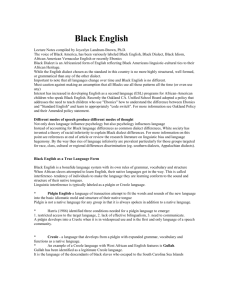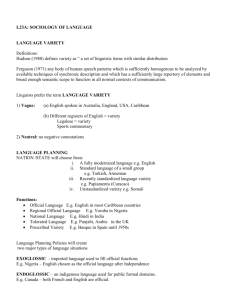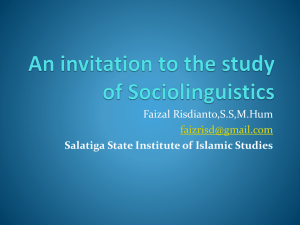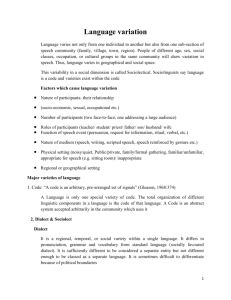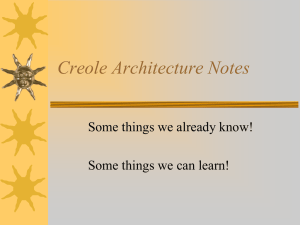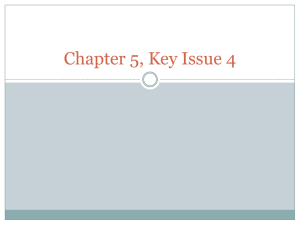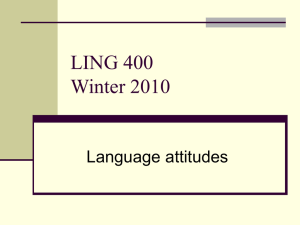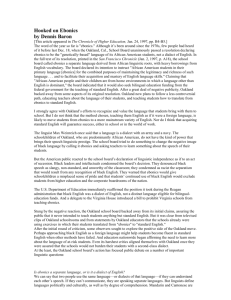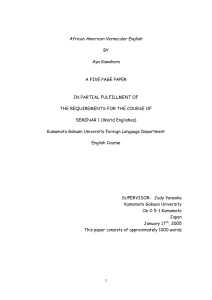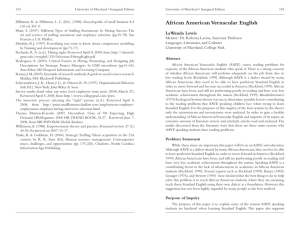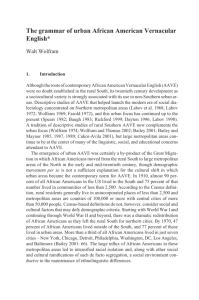Ebonics - Geoff Barton
advertisement
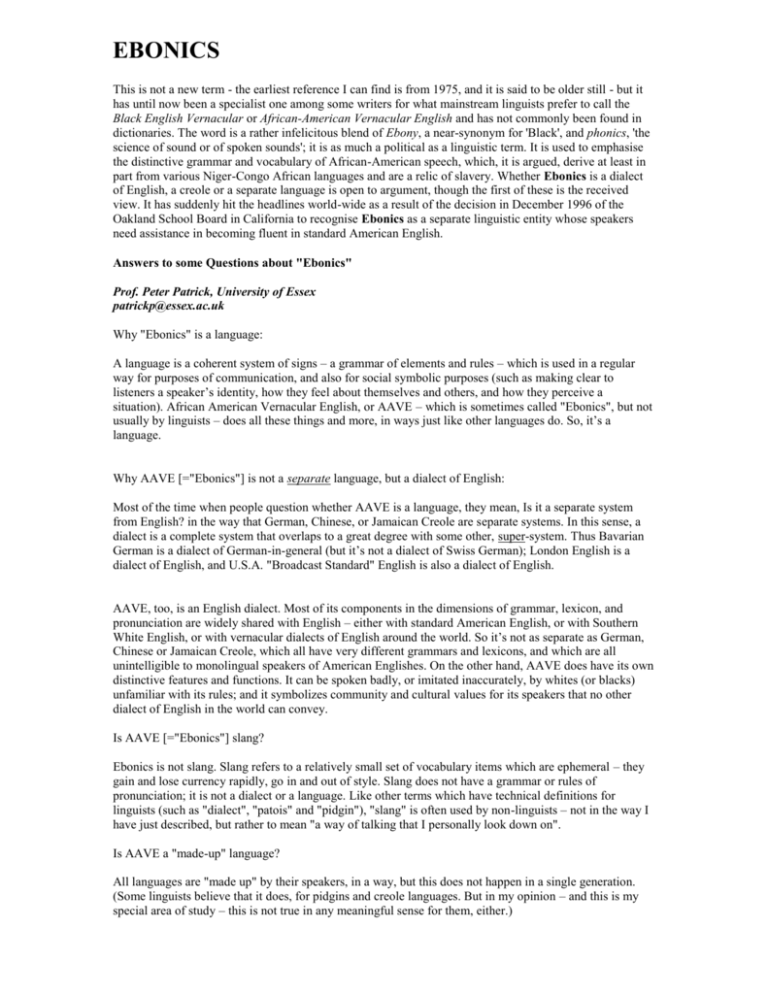
EBONICS This is not a new term - the earliest reference I can find is from 1975, and it is said to be older still - but it has until now been a specialist one among some writers for what mainstream linguists prefer to call the Black English Vernacular or African-American Vernacular English and has not commonly been found in dictionaries. The word is a rather infelicitous blend of Ebony, a near-synonym for 'Black', and phonics, 'the science of sound or of spoken sounds'; it is as much a political as a linguistic term. It is used to emphasise the distinctive grammar and vocabulary of African-American speech, which, it is argued, derive at least in part from various Niger-Congo African languages and are a relic of slavery. Whether Ebonics is a dialect of English, a creole or a separate language is open to argument, though the first of these is the received view. It has suddenly hit the headlines world-wide as a result of the decision in December 1996 of the Oakland School Board in California to recognise Ebonics as a separate linguistic entity whose speakers need assistance in becoming fluent in standard American English. Answers to some Questions about "Ebonics" Prof. Peter Patrick, University of Essex patrickp@essex.ac.uk Why "Ebonics" is a language: A language is a coherent system of signs – a grammar of elements and rules – which is used in a regular way for purposes of communication, and also for social symbolic purposes (such as making clear to listeners a speaker’s identity, how they feel about themselves and others, and how they perceive a situation). African American Vernacular English, or AAVE – which is sometimes called "Ebonics", but not usually by linguists – does all these things and more, in ways just like other languages do. So, it’s a language. Why AAVE [="Ebonics"] is not a separate language, but a dialect of English: Most of the time when people question whether AAVE is a language, they mean, Is it a separate system from English? in the way that German, Chinese, or Jamaican Creole are separate systems. In this sense, a dialect is a complete system that overlaps to a great degree with some other, super-system. Thus Bavarian German is a dialect of German-in-general (but it’s not a dialect of Swiss German); London English is a dialect of English, and U.S.A. "Broadcast Standard" English is also a dialect of English. AAVE, too, is an English dialect. Most of its components in the dimensions of grammar, lexicon, and pronunciation are widely shared with English – either with standard American English, or with Southern White English, or with vernacular dialects of English around the world. So it’s not as separate as German, Chinese or Jamaican Creole, which all have very different grammars and lexicons, and which are all unintelligible to monolingual speakers of American Englishes. On the other hand, AAVE does have its own distinctive features and functions. It can be spoken badly, or imitated inaccurately, by whites (or blacks) unfamiliar with its rules; and it symbolizes community and cultural values for its speakers that no other dialect of English in the world can convey. Is AAVE [="Ebonics"] slang? Ebonics is not slang. Slang refers to a relatively small set of vocabulary items which are ephemeral – they gain and lose currency rapidly, go in and out of style. Slang does not have a grammar or rules of pronunciation; it is not a dialect or a language. Like other terms which have technical definitions for linguists (such as "dialect", "patois" and "pidgin"), "slang" is often used by non-linguists – not in the way I have just described, but rather to mean "a way of talking that I personally look down on". Is AAVE a "made-up" language? All languages are "made up" by their speakers, in a way, but this does not happen in a single generation. (Some linguists believe that it does, for pidgins and creole languages. But in my opinion – and this is my special area of study – this is not true in any meaningful sense for them, either.) To say that a language is "made-up" tends to imply that it is "not real" in some important way – not as good as languages whose existence is undeniable. Languages are primarily spoken phenomena, and only secondarily written. But it is a historical fact that written languages are more prestigious than unwritten ones. This has nothing to do with the complexity or richness or the systematic nature of a language’s grammar, however. Unwritten languages are just as rich, complex and systematic as written ones. They simply tend to belong to cultures with a different grasp of technology – to groups of people who have not acquired literacy, or who live in a literate culture but have been disprivileged or denied access to education and technology. Why is AAVE not spoken by any country? Languages existed long before the modern world became organized into "countries", or nation-states. A languages doesn’t need to be the official speech of a nation-state in order to be real. Yet it is a fact that giving such official status tends to increase the prestige of a language. "African Americans", literally speaking, are people with African ancestry whose cultural home is in the Americas, from Nova Scotia to Argentina. There is no reason they should all speak English, and they do not. There is no reason they should not speak other languages and dialects than their national standards (English, Spanish, French, Dutch, Portuguese), and many of them do. Descendants of enslaved Africans are, by and large, peoples who have been discriminated against, who have been denied access to technologies and education, or educated in traditions foreign to their own experience. They are peoples who have had power – power to govern their own lives and societies – withheld from them by others. It shouldn't be surprising that the way they speak in their communities is often slandered as poor, inadequate or corrupt, and even said not to exist at all. It is not surprising that their speech forms have rarely been given official status by governments or education systems. It is not even surprising that many members of these communities have come to believe their native speech is inferior, simply because it is different. This is part of a historical pattern of discrimination, but it is not logically based on any facts about their languages. AAVE is just one of many African American language systems; others include Jamaican Creole, Haitian Creole, Louisiana French Creole, the Gullah language of the South Carolina and Georgia coasts, Palenquero of Colombia, Papiamentu of the Netherlands Antilles, and the Maroon languages of Guyana and Suriname (Saramakkan, Aluku, etc.), just to name a few. The speakers of these languages all share some history related to the Atlantic slave trade and colonialism, but are diverse in other respects; similarly, they share some aspects of grammar but are diverse in others. The extent to which these two dimensions (history and language structure) can be linked is the subject of the discipline known as pidgin and creole studies. Many controversies about the origins and resemblance of these language varieties are hotly debated by linguists and creolists – but almost all of them would agree with nearly everything I have said here. Who exactly uses "Ebonics"? One reason linguists don’t use the term "Ebonics" very happily is that it is very vague, and so such questions are hard to answer. We generally use the term "African American Vernacular English", or AAVE, instead to mean the kinds of speech characteristically spoken by working-class U.S. African Americans, within their community, at occasions calling for intimacy or informality. Linguists know very well that there are African Americans who cannot speak this dialect with native fluency; that there are some non-African Americans who can (though very few); and that almost all African Americans have some command of other forms of English, including Standard American English. In fact, there are characteristically African American ways of speaking the latter – which means there is a Standard African American English, too. A very large number of African American adults are perfectly at home with both AAVE and Standard American English, and are skilled at using each in the appropriate circumstances. It seems sensible, then, to speak of a generalized family of dialects – AAE, or African American English – which includes all the various ways of speaking characteristic of African Americans: standard and vernacular, working- and middle-class, in settings formal and professional or informal and intimate. It is sensible, also, to use the term AAVE for a particular branch of AAE. When people say "Ebonics," they often refer to this system, which linguists have studied the most. PIDGINS AND CREOLES INTRODUCTION Can you guess what language this is? These lines are taken from a famous comic strip in Papua New Guinea: "Sapos yu kaikai planti pinat, bai yu kamap strong olsem phantom." "Fantom, yu pren tru bilong mi. Inap yu ken helpim mi nau?" "Fantom, em i go we?" Translation: 'If you eat plenty of peanuts, you will come up strong like the phantom.' 'Phantom, you are a true friend of mine. Are you able to help me now?' 1Where did he go?' A simplified language derived from two or more languages is called a pidgin. It is a contact language developed and used by people who do not share a common language in a given geographical area. It is used in a limited way and the structure is very simplistic. Since they serve a single simplistic purpose, they usually die out. However, if the pidgin is used long enough, it begins to evolve into a more rich language with a more complex structure and richer vocabulary. Once the pidgin has evolved and has acquired native speakers ( the children learn the pidgin as their first language), it is then called a Creole. An example of this is the Creole above from Papua New Guinea, Tok Pisin, which has become a National language. Reasons for the development of Pidgins In the nineteenth century, when slaves from Africa were brought over to North America to work on the plantations, they were separated from the people of their community and mixed with people of various other communities, therefore they were unable to communicate with each other. The strategy behind this was so they couldn't come up with a plot to escape back to their land. Therefore, in order to finally communicate with their peers on the plantations, and with their bosses, they needed to form a language in which they could communicate. Pidgins also arose because of colonization. Prominent languages such as French, Spanish, Portuguese, English, and Dutch were the languages of the coloni zers. They traveled, and set up ports in coastal towns where shipping and trading routes were accessible. There is always a dominant language which contributes most of the vocabulary of the pidgin, this is called the superstrate language. The superstrate language from the Papua New Guinea Creole example above is English. The other minority languages that contribute to the pidgin are called the substrate languages. In the United States, there is a very well known Creole, Louisiana Creole, which is derived from French and African Languages. You most likely have heard of "Cajun" which is a developed dialect of this Creole. Can you guess what major language (the superstrate) contributed to the vocabulary in each of these Creoles? This table is taken from Janet Holmes, " An Introduction to Sociolinguistics": a. mo pe aste sa banan b. de bin alde luk dat big tri c. a waka go a wosu d. olmaan i kas-im chek e. li pote sa bay mo f. ja fruher wir bleiben g. dis smol swain i bin go fo maket I am buying the banana they always looked for a big tree he walked home the old man is cashing a check he brought that for me Yes at first we remained this little pig went to market "The Eskimos have hundreds of words for snow." This story is constantly being repeated, with various numbers given, despite the fact that it has no basis at all. No one who repeats this pseudo-factoid can list the hundreds of words for you, or even cite a work that does. They just heard it somewhere. The anthropologist Laura Martin has traced the development of this myth (including the steady growth in the number of words claimed). Geoffrey Pullum summarizes her report in THE GREAT ESKIMO VOCABULARY HOAX (1991). How many words are there really? Well, the Yup'ik language in particular has about two dozen roots describing snow or things related to snow. This is not particularly significant; English can amass about the same total: snow, sleet, slush, blizzard, flurry, avalanche, powder, hardpack, snowball, snowman, and other derivatives. The Yup'ik total could be greatly expanded by other derived words, since the Inuit languages can form hundreds of words from a single root. But this is true of all words in the language (and indeed of all agglutinative languages), not just the words for snow. ANSWERS: a. b. c. d. e. f. g. French based Seychelles Creole English based Roper River Creole English based Saran English based Cape York Creole French based Guyanais German based Papua New Guinea Pidgin German English based Cameroon Pidgin
